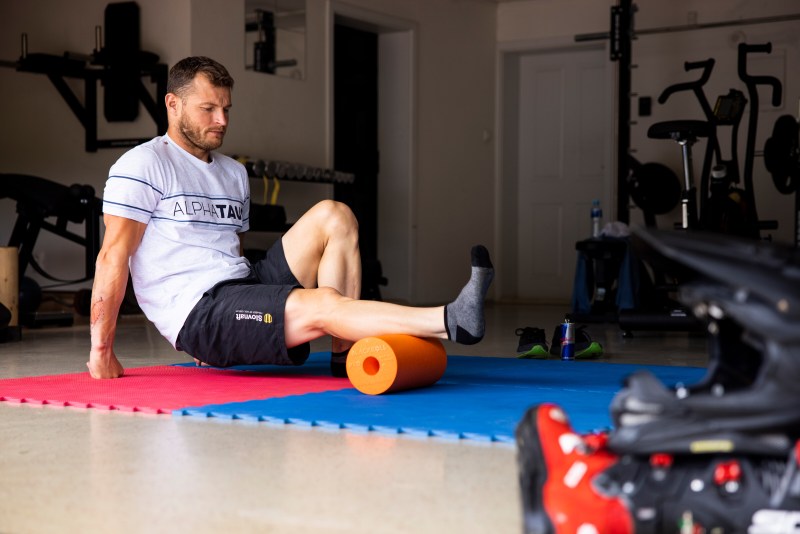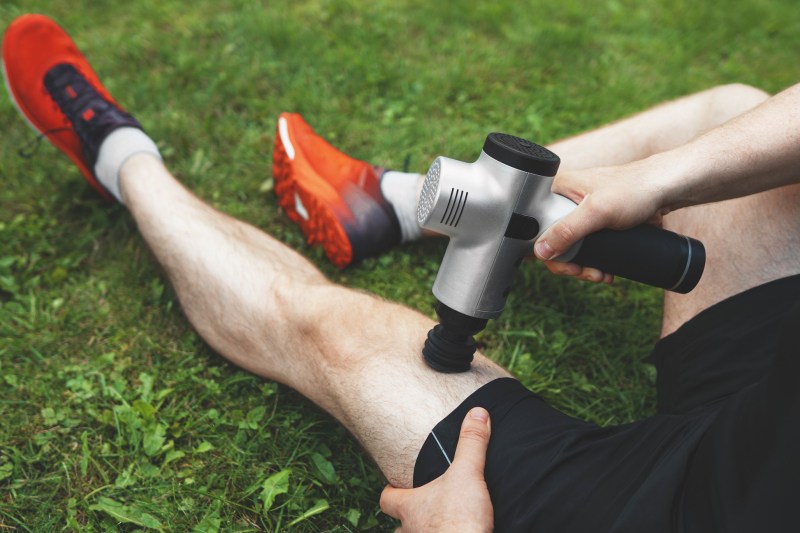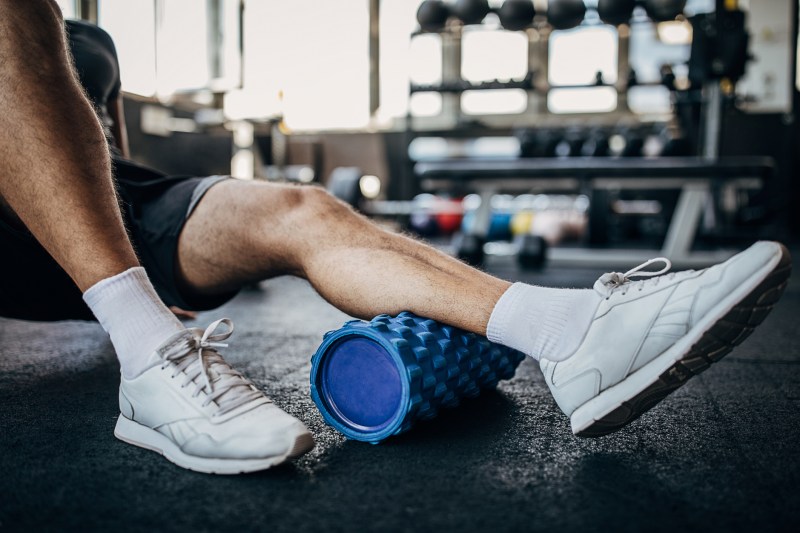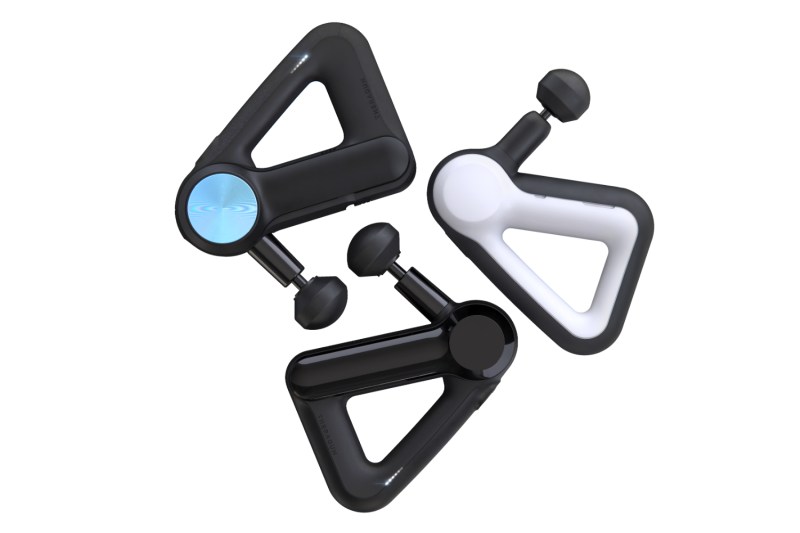
Foam rollers and massage guns are two of the most popular and effective tools for mobility, muscle recovery, and pre-workout muscle activation, but most of us aren’t sure exactly which we should be using. You might be wondering when and how to best incorporate each tool into your pre and post-workout routines.
Though both foam rollers and top-rated massage guns increase circulation and ease muscle tension, knowing the nuanced differences between them will help you maximize the effectiveness of each recovery tool.

A medical pro answers all the common questions about massage guns vs. foam rollers
To help shed light on the benefits, drawbacks, differences, and best uses of popular foam rollers and massage guns for workout recovery, we turned to Dr. Grayson Wickham, PT, DPT, CSCS, Doctor of Physical Therapy, Certified Strength and Conditioning Specialist, and founder of Movement Vault, a website that helps people alleviate pain, prevent injury, and increase flexibility and mobility.
Why are foam rollers and massage guns useful recovery and mobility tools?
Foam rollers and massage guns can be used to release tension in and increase the mobility of your muscles, fascia, and other connective tissue surrounding a joint by sending input to your nervous system. Dr. Wickham said that the mobility benefits of foam rollers and massage guns are especially critical these days given the prevalence of overly tight, restricted hips and other compromised tissues and joints brought on by sitting at desks for hours at a time and movement pathologies characteristic of our modern lifestyle. “It all boils down to lack of varied movement and the positions that you spend the most time in. Today, most people do not move as much as their body was designed to, and on top of that, don’t move in enough varied positions and ranges of motion throughout their day-to-day activities,” he explained.
According to Dr. Wickham, the typical modern lifestyle tends to be relatively devoid of rotational movements, such as chopping or picking something up on your right side and putting it down on your left side. Instead, whether in the gym or in daily life, we tend to focus on forward and backward movements like walking, squats, and running. “On top of the lack of varied movement throughout the day, most people spend way too much time sitting hunched over on the couch or at their desk,” noted Dr. Wickham, who said this immobility coupled with poor posture leads to tight muscles, tendons, ligaments, fascia, and joints.
Here’s where foam rollers and massage guns come in. “The best solution is to be mindful of your posture throughout the day, get varied movement throughout your day, and incorporate an effective stretching and mobility routine several times a week,” Dr. Wickham said. “An effective mobility routine will include muscle and fascia release techniques using tools such as a foam roller or massage gun, active stretches, and muscle activation techniques.”
How do foam rollers and massage guns work?
Wondering how massage guns and foam rollers work? Foam rolling and massage guns are considered types of manual therapy, which refers to any technique that sends input to your nervous system in order to relax your muscles and connective tissue, ultimately increasing the range of motion in the muscle or around a joint. Contrary to popular belief, foam rollers and massage guns aren’t physically breaking up knots in muscles; rather, they are stimulating the nervous system to relax tension in the surrounding tissues.

What are the benefits and drawbacks of foam rollers?
Dr. Wickham said that foam rollers can improve flexibility and mobility in a muscle, fascia, or joint by decreasing muscle tension or tone and by increasing blood flow in the treated area. However, he said the benefits are relatively short-lived. “When you foam roll a tight muscle group using effective technique, you will almost immediately have less tension in that muscle group and be able to move your joint through a greater range of motion. The downfall is that this decreased muscle tension only typically lasts for a few hours — or a day or two at most,” he explained. “This is why it is extremely important to perform an active stretch for a muscle immediately after you foam roll that same muscle.”
The other main drawbacks to foam rollers include their big, bulky size and the large, open floor space you need to use them properly. As such, they aren’t particularly travel-friendly. It can also be challenging to use them properly, requiring physical strength as well as instruction on the proper technique to garner maximal effectiveness.
Dr. Wickham said there are a few contraindications for using foam rollers as well, including “foam rolling over burned skin, a wound that hasn’t healed, any type of tumorous growth, or anywhere that causes intense pain, numbness, and tingling, or a burning sensation.”

What are the benefits and drawbacks of massage guns?
Massage guns are placed over a muscle and the percussive, repetitive motion of the head stimulates the nervous system in a concentrated way, triggering the relaxation of the surrounding muscles and connective tissues. The benefits, drawbacks, and contraindications of massage guns mostly mirror those of foam rollers. “The main difference is that massage guns offer a more aggressive and concentrated stimulus to a muscle.” Additionally, massage guns such as the Theragun Prime pictured above are much smaller, more portable, and easier to use, but are also more expensive.
Which is better for recovery: Foam rollers or massage guns?
Ultimately, foam rollers and massage guns both aid recovery in the same way — by stimulating the parasympathetic nervous system to relax muscles and tissues and by increasing blood flow to the treated tissues. Determining which recovery tool is “better” is largely a matter of personal preference and needs.
“I like the foam roller specifically for recovery as it is more affordable, versatile, and allows you to put your entire body weight onto it, giving a deeper stimulus into your muscle tissue, which can yield a better input to your nervous system, leading to better recovery results,” Dr. Wickham shared.
“I like the massage gun as it allows you to send a more aggressive and concentrated input to a muscle. You can also use your massage gun almost anywhere and don’t need to carry around a big foam roller or have open floor space to use it,” he said, adding one final point in favor of massage guns: “Sometimes it can also be difficult to apply enough pressure to the backs of your lower leg calf muscles using a foam roller. If this is the case, a massage gun is a good option to use for these specific areas.”
How to use foam rollers and massage guns for workout recovery
Whether you opt to use a foam roller or a massage gun to facilitate workout recovery, the same general principles apply. “Focus on the specific muscle groups that you just worked out. The larger the muscle is, the more time you will need to spend going up and down that muscle,” Dr. Wickham explained.
For example, your quadriceps will take longer than the triceps; perhaps devote 2-3 minutes moving up and down your quadriceps, and a minute of going up and down your triceps. Dr. Wickham recommends spending about 10 minutes on your upper body and 10 to 12 minutes on your lower body after a workout.
Can you use a massage gun or foam roller on an injured muscle?
It’s strongly advised against using either a massage gun or a foam roller on an injured muscle. And here’s why. Both massage guns and foam rollers can be quite intense, and using them on an injured muscle could actually worsen inflammation and delay healing.
Also, injured muscles are already compromised, and applying additional pressure with these tools could potentially cause further microscopic tears or micro traumas. Using either tool on an injured muscle is likely to be quite painful, potentially hindering your recovery and discouraging essential rest.

Final thoughts
Foam rollers and massage guns are both tools used to release tension in muscles, fascia, and other connective tissues. As such, they can be important and effective components of your body maintenance and recovery routines. “If your goal is to improve your flexibility and mobility and achieve lasting improvements, you will always want to follow up your foam rolling or massage gun muscle release work with an active stretch for that same area,” Dr. Wickham advised. “It’s just like the adage ‘an ounce of prevention is worth a pound of cure’ — dedicate time to maintaining your body and joints using effective mobility techniques such as utilizing a foam roller or massage gun.”
Editors' Recommendations
- Resistance bands vs weights: Which are better for building muscle?
- 5 effective foam roller back exercises your body will thank you for
- Overhead tricep extensions vs. cable pushdowns: Study says one of these builds more muscle
- These are the benefits of stretching to help you avoid injury
- This is why actively stretching is important for you to get a better workout




